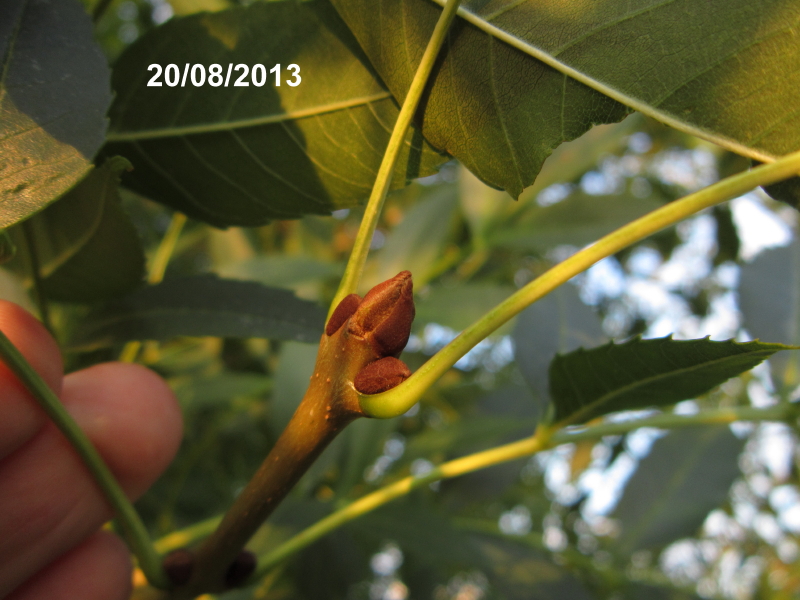Fraxinus angustifolia Vahl (Medit., Caucasus) – A rare but increasing escape from cultivation. First recorded in the wild in Belgium in 2009 in Hertsberge (probably ephemeral). The first naturalizing populations were discovered near Frameries and Quaregnon (southwest of Mons) in 2010. Subsequently also found in abundance in the valley of riverlet Poekebeek in Tielt in 2011. Since 2013 also known in quantity from the canal Kortrijk-Bossuit and spreading there to nearby suitable habitats. This species is a popular street tree now and readily escapes where ever planted. As such, it is known now from widely scattered localities.
Fraxinus angustifolia and F. excelsior are closely related and both are mostly distinguished on quantitative rather than qualitative characters (Jarni & al. 2011). Surprisingly, these two species were accommodated in different sections of the genus (section Racemosae and section Paniculatae respectively) by Kárpáti (1970), based on inflorescence characters. In some river valleys in France where both species grow in close proximity introgression seems to occur (Tison & de Foucault 2014 and additional references therein). Wallander (2008), on the contrary, suggested there is no gene flow between these two species, based on molecular data. F. angustifolia is usually distinguished from F. excelsior by its paler buds (brown vs. black) and its smaller, often more or less leathery leaves.
Fraxinus angustifolia is a variable species. Several subspecies have widely been recognized, among others subsp. angustifolia and subsp. oxycarpa (Bieb. ex Willd.) Franco et Rocha (syn.: F. oxycarpa Bieb. ex Willd.), the latter with a more southeastern distribution in Europe. The individuals currently found in Belgium and adjacent territories most closely resemble the latter or even tend towards F. excelsior (Lambinon & Verloove 2012). Such more or less intermediate plants are sometimes referred to as F. ×stenobotrys Gandoger. According to other authors (e.g. Jarni & al. 2011) it makes no sense to distinguish any infraspecific taxa within F. angustifolia. Kárpáti (1970), on the contrary, proposed a very narrow species concept and accepted both these subspecies as distinct species that even belong to different sections of the genus. This is, however, in discordance with molecular data (e.g. Wallander 2008).
In some of its Belgian localities (e.g. in Tielt) Fraxinus angustifolia reproduces in extreme abundance. Future invasive behavior cannot be ruled out, especially in areas where this species is planted close to natural, vulnerable habitats. This species is known to form dense monocultures in riparian areas and along drainage lines, spreading via suckers and preventing the regeneration of native species, for instance in Australia and South Africa (numerous references on the internet).
|
|
|
|
|
|
 |
 |
Selected literature:
Bartha D. (2015) Eine wenig bekannte Esche: die Ungarische Esche Fraxinus angustifolia Vahl subsp. danubialis Pouzar: Teil I: Geschichte der Entdeckung, Erkennung und Benennung der Unterart. Mitt. Deutsch. Dendrol. Gesell. 100 : 197-203. [available online at: https://www.researchgate.net/publication/280037277_Eine_wenig_bekannte_E...
Bournérias M. (1979) Le frêne dit "oxyphylle", espèce méconnue dans le Bassin de la Seine. Cah. Nat. 34(2): 73-76.
Bowen H. (1992) An overlooked Ash. B.S.B.I. News 60: 41. [available online at: http://archive.bsbi.org.uk/BSBINews60.pdf]
Corillion R. (1992) Les végétations à Ulmus laevis Pallas et Fraxinus angustifolia Vahl. des rives de la Loire angevine. Bull. Soc. Etudes Sci. Anjou 14: 103-111.
Fernández Prieto J.A, Amigo J. & Guitián J. (1987) Sobre la presencia de Salix salviifolia Brot. y Fraxinus angustifolia Vahl en la cuenca del río Navia (Galicia-Asturias). An. Jard. Bot. Madrid 44(1): 109-112. [available online at: http://www.rjb.csic.es/jardinbotanico/ficheros/documentos/pdf/anales/198...(1)_109_112.pdf]
Franco J. & Rocha Afonso M.L. (1971) Flora Europaea: notulae systematicae ad floram Europaeam spectantes: no. 11. Oleaceae (186) Fraxinus angustifolia Vahl. Bot. J. Linn. Soc. 64(4): 377.
Fukarek P. (1960) Différences morphologiques et anatomiques entre le Frêne commun ( Fraxinus excelsior L.) et le Frêne oxyphylle ( F. angustifolia Vahl.). Bull. Soc. Bot. Fr. 107(5-6): 192-199. [available online at: http://www.tandfonline.com/doi/abs/10.1080/00378941.1960.10837933]
Green P.S. (1985) Fraxinus rotundifolia Mill., F. parvifolia Lam. or F. angustifolia Vahl? Kew Bull. 40(1): 131-134.
Green P.S. (1988) (914) Proposal to conserve the name Fraxinus angustifolia Vahl against F. rotundifolia Mill. (Oleaceae). Taxon 37(2): 488-489.
Jarni K., Westergren M., Kraigher H. & Brus R. (2011) Morphological variability of Fraxinus angustifolia Vahl in the north-western Balkans. Acta Soc. Bot. Poloniae 80(3): 245-252. [available online at: https://pbsociety.org.pl/journals/index.php/asbp/article/view/asbp.2011....
Kárpáti Z.E. (1970) Eine kritisch-taxonomische Übersicht der in Europa wildwachsenden Eschen-Arten und deren Unterarten. Feddes Repert. 81(1-5):171-186.
Kutbay H.G. (2000) Sclerophylly in Fraxinus angustifolia Vahl. subsp. oxycarpa (Bieb. ex Willd.) Franco and Rocha Afonso and Laurus nobilis L. and edaphic relations of these species. Turk. J. Bot. 24(2): 113-119. [available online at: https://journals.tubitak.gov.tr/botany/abstract.htm?id=3863]
Lambinon J. & Verloove F. (2012) Nouvelle Flore de la Belgique, du Grand-Duché de Luxembourg, du Nord de la France et des Régions voisines (Ptéridophytes et Spermatophytes). Sixième édition. Jardin botanique national de Belgique, Meise: CXXXIX + 1195 p.
Monin J. & Poinsot H. (1971) Au sujet des frênes de Bourgogne. Bull. Soc. Bot. France 117(7-8): 399-403.
Tison J.-M. & de Foucault B. (coord.) 2014) Flora Gallica. Flore de France. Editions Biotope, Mèze : xx + 1196 p.
Wallander E. (2008) Systematics of Fraxinus (Oleaceae) and evolution of dioecy. Pl. Syst. Evol. 273: 25-49. [available online at: http://www.oleaceae.info/publications/Wallander2008.pdf]

